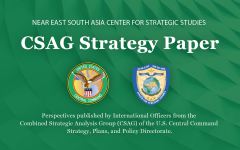Understanding the Iranian Threat Network
August 6, 2024 2024-08-06 16:53Understanding the Iranian Threat Network
Understanding the Iranian Threat Network
CSAG STRATEGY PAPER
CDR Hubert Mróz, Polish Navy (CSAG/CCJ5)
29 July 2024
Introduction:
The Iranian Threat Network (ITN) has emerged as a complex and multifaceted challenge in the CENTCOM Area of Operations (AOR). This strategic paper aims to provide a comprehensive understanding of the ITN, its models, significance, and the nuanced threat perceptions it engenders across the CENTCOM AOR. Furthermore, it proposes a robust methodology to gauge the ITN threat perspectives of countries in the region and identify opportunities for cooperation to mitigate ITN influence. This paper will explore the various models and manifestations of the ITN, including its state-sponsored elements, proxy forces, and asymmetric capabilities, to develop a holistic understanding of its operational dynamics.
The ITN’s significance lies in its ability to project Iranian regime influence, sow instability, and undermine the security and sovereignty of countries within the CENTCOM AOR. This is achieved through malign activities, ranging from usurping sovereign security constructs with shadow security organizations to interference with political processes, with far-reaching implications for the Middle East and beyond.
A key characteristic of the ITN model is its remarkable flexibility and adaptability. The network has demonstrated the capacity to evolve its tactics, techniques, and procedures in response to changing circumstances, posing a dynamic and persistent challenge to regional security. Understanding the ITN’s adaptive nature is crucial for developing effective countermeasures.
The perception of the threat from the ITN varies across countries within the CENTCOM AOR, reflecting the complex web of regional dynamics and individual relations with Iran. To better understand the ITN’s calibrated efforts and its impact on the CENTCOM AOR, this paper proposes a comprehensive 4-phased methodology. This approach combines literature study, deductive research, inductive research, and abductive research, as well as employing three analytical models (all described and explained below). By applying this methodology, CENTCOM can develop a more nuanced understanding of the ITN threat and identify opportunities for cooperation to mitigate its influence. This paper builds upon and complements previous research on deterrence strategy, as presented in the 2024 CSAG Strategy Paper titled “Deterring the ‘Exquisite Diplomat’: Unpacking the Complexities of U.S.-Iran Deterrence Dynamics.” In this regard, there may be some repetition of concepts and information between the two papers. However, these repetitions are necessary to ensure that the current paper provides a comprehensive and self-contained exploration of the ITN and its implications, without requiring the reader to refer extensively to the previous work; it’s stand alone.
Key Points:
- The Iranian Threat Network (ITN) poses a complex and multifaceted challenge in the region.
- The significance of the ITN lies in its ability to project influence, sow instability, and undermine security and sovereignty, with far-reaching implications for the geopolitical landscape.
- The ITN is characterized by its remarkable flexibility and adaptability.
- The threat perception of the ITN varies across countries within the CENTCOM AOR.
- CSAG proposes a comprehensive methodology for more nuanced understanding of the ITN.
View other USCENTCOM Combined Strategic Analysis Group (CSAG) papers here.
The opinions and conclusions expressed herein are those of a number of international officers within the Combined Strategic Analysis Group (CSAG) and do not necessarily reflect the views of United States Central Command, not of the nations represented within the CSAG or any other governmental agency.






